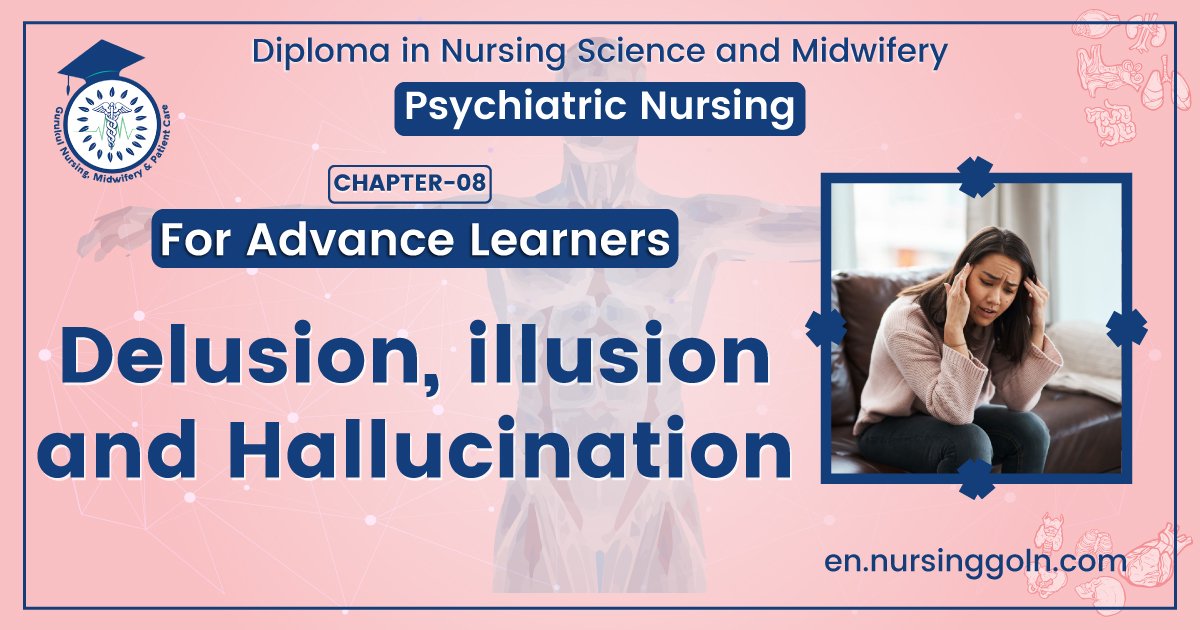Delusion, illusion and hallucination – This book covers the entire syllabus of “Psychiatric Nursing” prescribed by the Universities of Bangladesh- for Basic and diploma nursing students. We tried to accommodate the latest information and topics. This book is an examination-friendly setup according to the teachers’ lectures and examination questions.
At the end of the book previous university questions are given. We hope in touch with the book students’ knowledge will be upgraded and flourish. The unique way of presentation may make your reading of the book a pleasurable experience.

Delusion, illusion and hallucination
Delusion
Delusion is a false fixed belief. It is a disturbance in the content of thinking.
Characteristics of delusion:
1. The person is convinced about a particular belief.
2. It cannot be corrected by reason or logic.
3. It is not shared by the members of the same community.
(Ref: S Nambl/2/35)
Or,
A delusion is a false belief, usually unique to the individual, which is not susceptible to modification or correction by logical persuasion or by compelling contrary evidence.
[Ref-Mary Topalis and Donna C. Aguilera’s/7/197]
Or,
A false belief that is firmly maintained even though it is not shared by others and is contradicted by social reality.
[Ref- BT Basavanthappa/1/736]
Classification/Type of delusion:
1. Delusions of persecution (paranoid delusion): The person is suspicious of people believes that others are trying to harm him, trying to kill or poison him.
2. Delusions of grandeur (Grandiose): Suddenly, the person starts to harbor a false belief that he is extraordinarily powerful, wealthy and a very important person. He believes that he can achieve anything and everything, and feels that the entire world is under him.
3. Delusions of jealousy or Infidelity: False belief that his spouse is unfaithful and is having extra-marital affairs.
4. Delusions of control (Passivity phenomenon): False belief that his thinking actions and feelings are all not his own but are being controlled by some external agencies.
5. Nihilistic delusions: The false belief that the world is going to end or his body parts are missing etc.
6. Hypochondriacal delusions: False belief that he has some incurable disease.
[Ref: S Nambi/2/35/]
Psychiatric disorders in which delusion occurs:
| Psychiatric Disease | Type of delusion |
| Schizophrenia |
|
| Mania |
|
| Depression |
|
| Alcoholism |
|
| Organic mental disorders |
|
[Ref: S Nambi/24/35/]

Illusion
This is a perceptual disturbance, the misinterpretation of a real sensory stimulus. Example: On seeing a rope in the dark, the person mistakes it for a snake. This can occur in delirium during intoxication.
[Ref: S Numbi/24/36]
Or,
An illusion is a distortion of the senses, which can reveal how the human brain normally organizes and interprets sensory stimulation.
Hallucination
A hallu-cination is a false perception which occurs without an external stimulus. Example Hearing a voice when no one is around.
[Ref: S Nambi/2/36/]
Hallu-cinations are spontaneous unwilled sense perceptions, experienced as arising outside the self, for which there is no external basis.
[Ref-Mary Topals and Donna C. Aguilera’s/7/1991]
A false sensor perception that is, without external stimuli, or a sensory perception that does not exist in reality, such asseeing “visions” or hearing “voices”.
[Ref- BT Basavanthappa/1/736]

Classification of hallucination:
1. Auditory hallu-cination: This is the most common type of hallucination. It is hearing voices when nobody is around. It can occur in schizophrenia, paranoid disorders, and epilepsy and in alcohol withdrawal state.
2. Visual hallu-cination: This hallucination consists of seeing figures, objects, shadows, ‘ghosts’ etc. When there is actually nothing. Occasionally, it occurs in schizophrenia sign of organic mental disorde4 especially epilepsy.
3. Olfactory hallucination: This hallucination consists smelling pleasant or unpleasant odor in the absence of stimuli. Common in epilepsy (temporal lobe epilepsy).
4. Gustatory hallucination or hallucination of taste: Usually the person has a peculiar taste in his mouth. This is occasionally present in epilepsy, rarely in paranoid disorder.
5. Tactile hallucination or hallucination of touch: A feeling of peculiar touch or insects crawling over the body as seen in cocaine intoxication.
[Ref: S Nambi/2/36]
Differences between hallucination and illusion:
| Illusion | Hallucination |
| Illusions are abnormal perceptions of real stimuli. | Hallucination is a sensory perception which occurs without any external stimuli. |
| They occur when the general level of sensory stimulation is reduced and when attention is notfocused on the relevant sensory modality | They are generally indications of a psychiatric disorder, they occasionally occur in healthy people, |
| It can be terminated at will. | Hallucinations cannot be terminated at will. |
Read more:
